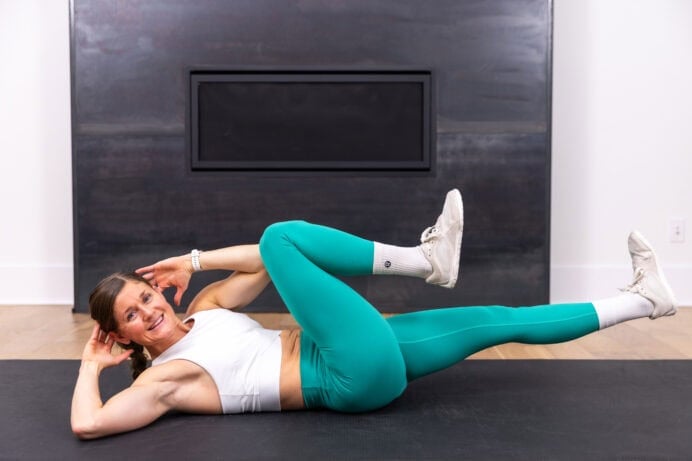
12 Leg Exercises and How to Create the Best Leg Workout
These strength-focused leg exercises target the quads, hamstrings, glutes, calves and core. The compound and isolation exercises are designed to build power, stability and definition. This workout combines squats, deadlifts, lunges and single-leg movements for a balanced, efficient leg day. Each exercise is structured to maximize muscle engagement, improve form and boost overall athletic performance.
When I plan a leg day, I like to include a variety of strength training exercises that will challenge me to move in different planes of motion. Strong legs create balance, boost overall athletic performance and improve everyday movement – from climbing stairs to sprinting after your kids. A strong lower body also supports better posture and helps prevent injuries.
The best leg workout targets all the major muscle groups: quads, hamstrings, glutes, thighs, calves and core. I build my workouts around compound exercises that work multiple muscles at once because they give me the most bang for my buck. Think squats, deadlifts, lunges and hip thrusts. These are non-negotiables in my leg days because they train strength, stability and coordination all at once.
If you’re building your own leg day, start with the biggest, most demanding lifts first. I always begin with squats or deadlifts since those require the most energy and focus. From there, I move into unilateral exercises; things like step-ups, Bulgarian split squats or single-leg Romanian deadlifts to help correct imbalances and improve stability. Finally, I finish with isolation moves, such as hamstring curls, calf raises or glute bridges, to target smaller, stabilizing muscles.
In terms of structure, I like to stick to about 4-6 exercises per session. That’s enough volume to challenge my muscles without overtraining. I’ll typically perform 3 sets of 10-12 reps of each movement, focusing on controlled reps and proper form. The key is intensity or pushing myself close to failure on each set while maintaining good form.
One of the best parts about leg training is how much it benefits the rest of the body. Leg workouts elevate your heart rate and increase calorie burn because the lower body contains some very large muscle groups. Strong legs mean better athletic performance, greater stability and a more powerful foundation for any type of movement.
If I had to pick 1 exercise to always include in a leg day, it’d be squats. Incorporating squats into my routine has completely changed my strength and physique. They’re such a functional exercise that builds muscle in my quads and glutes and strengthens my core. Whether it’s bodyweight squats, goblet squats or heavy barbell back squats, this single movement pattern forms the cornerstone of every effective leg workout I design. If you struggle with knee pain during squats, try reducing your depth or incorporating wall sits.
If you’re building your own leg day, remember: focus on the big lifts first, balance bilateral and unilateral exercises and train with purpose. Your legs do more for your body than you might realize, and when you train them consistently, the results speak for themselves.
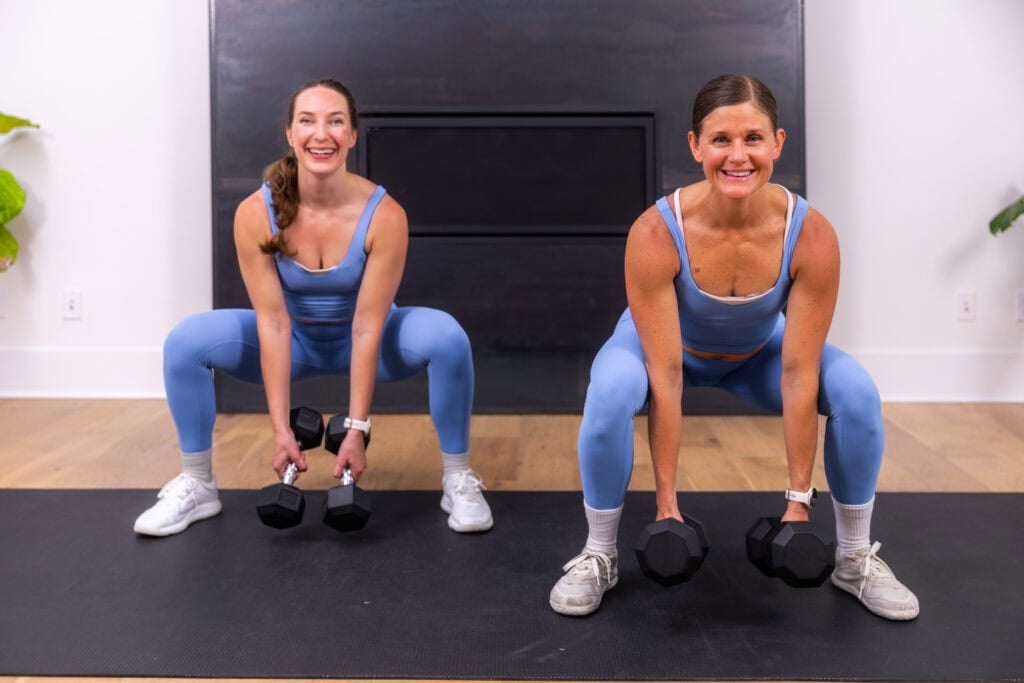
Workout Equipment:
A medium-to-heavy set of dumbbells. I suggest anywhere from 5-25 lbs.
Workout Instructions:
Note that this is a list of my favorite dumbbell leg exercises. If you prefer a guided home workout video (complete with a warm-up and cool-down), try these 7 Compound Leg Exercises.
How To Use This Dumbbell Leg Workout:
- Beginner: 30 seconds work, 15 seconds rest. Perform each exercise x1 set.
- Intermediate: 40 seconds work, 20 seconds rest. Perform each exercise x2 sets.
- Advanced: 45 seconds work, 15 seconds rest. Perform each exercise x3 sets.
Workout Outline
1. Dumbbell Squat
Targets: Legs, glutes, quadriceps, hamstrings, hips and core.
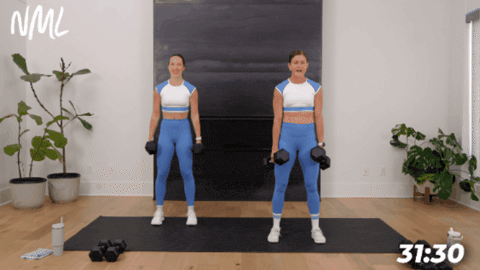
How to Do a Dumbbell Squat
- Start standing with your feet shoulder-width apart and your knees slightly bent. Hold a pair of dumbbells at your sides, palms facing in towards your body.
- Lower down into a squat position, lowering your hips down parallel with your knees. Drive your knees out toward your outer toes.
- Drive through your heels to stand tall, returning to a standing position.
2. Goblet Squat
Targets: Legs, glutes, quadriceps, hamstrings, hips and core.
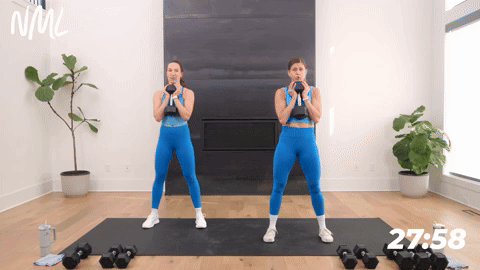
How to Do a Goblet Squat
- Start standing with your feet shoulder-width apart, knees slightly bent, holding a single dumbbell at your chest (vertically so the dumbbell is touching your collarbone and sternum).
- Lower down into a squat position, lowering your hips down parallel with your knees. Drive your knees out toward your outer toes.
- Drive through your heels to stand tall, returning to a standing position.
3. Romanian Deadlift
Targets: All the posterior chain muscles, including the hamstrings, glutes, core, lats and lower back.
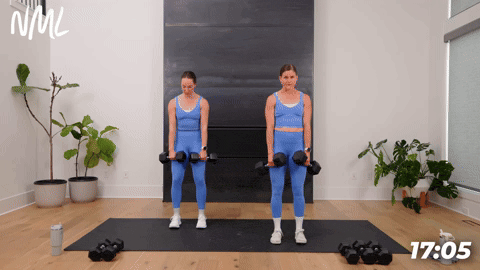
How to Do a Romanian Deadlift
- Stand with your feet hip-width apart, holding a dumbbell in each hand in front of your hips (palms facing in towards your body).
- Hinge at the hips, pushing your hips back towards the wall behind you as you glide the dumbbells down the front of your legs, keeping your core tight, slightly bending both knees. Lower your dumbbells until you feel a stretch in the hamstrings. The range of motion will look different for everyone.
- Drive through your heels to push your hips forward, pulling the dumbbells back up towards your hips and returning to the starting position. Aim for full hip extension at the top of the movement.
4. Single-Leg Deadlift
Targets: The posterior chain (backside of body), including the glutes, hamstrings, lower back and core muscles.
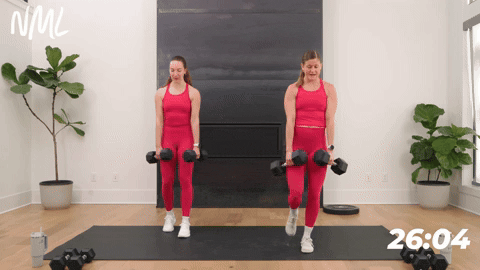
How to Do a Single-Leg Deadlift
- Start standing with feet hip-width apart, knees slightly bent. Hold a dumbbell in each hand in front of you at your thighs, palms facing in towards your body.
- Transfer your weight into your right foot and kickstand, or float your left foot off the ground, balancing on your right leg.
- With your right knee slightly bent, hinge at your hips, extending your left leg long behind you. Push your glutes back towards the wall behind you, lowering the dumbbells along the front of your thighs.
- Lower until you feel a stretch in your right hamstring (back of your standing leg) at the bottom of this movement. The range of motion looks different for everyone.
- Drive through your front right heel, squeezing your glutes and hamstrings to push your hips forward and stand tall, returning to a standing position. Bring your floating back left leg up to meet your right leg again.
Modification: Kickstand your non-working leg rather than floating it. Keep 80% of your weight in your front leg and 20% in your back toes.
5. Good Mornings
Targets: Hamstrings, gluteus maximus, erector spinae and lower back muscles.
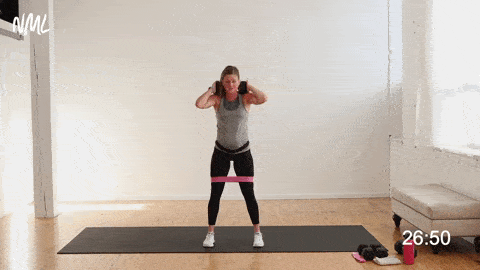
How to Do a Good Morning
- Start in a standing position, feet shoulder-width apart, core engaged, hands placed behind your head. Option to add weight by resting 1 dumbbell, horizontally, on your upper back, neck and shoulders. Holding each head of the dumbbell with 1 hand.
- With a slight bend in your knees, hinge forward at the hips until your torso is parallel to the ground. Core engaged and spine neutral (back flat).
- You should feel a stretch in your hamstrings (back of the legs) at the bottom of the movement.
- Reverse the movement, driving through your heels to stand tall, returning to the starting position (torso upright).
6. Walking Lunges
Targets: Quads, glutes, hamstrings, inner thighs and core.

How to Do a Walking Lunge
- Start by standing at the back of your space, feet hip-distance apart. Hold a dumbbell in each hand, palms facing in towards each other (hammer curl grip).
- Step your right leg forward into a front lunge, dropping your back left knee down towards the ground as you lower your hips until both knees reach a 90-degree angle, front thigh is parallel to the floor.
- Drive through the front right heel to stand tall. Rather than stopping at the top, immediately step your left leg into a front lunge. Drop your back right knee down towards the ground as you lower your hips until both knees reach a 90-degree angle, front thigh parallel to the floor.
- Repeat, alternating front lunges as you move forward in a walking motion.
Modification: Stay in place, performing split lunges instead of walking lunges.
7. Reverse Lunges
Targets: Legs, glutes, quads, hamstrings and core.
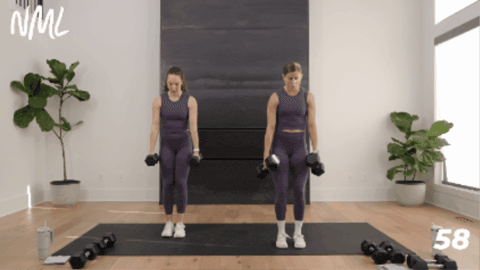
How to Do a Reverse Lunge
- Start standing in a neutral position, feet hip-width apart, holding a dumbbell in each hand, palms facing in towards each other (hammer curl grip).
- Step your left foot back into a reverse lunge. Lower your left knee towards the mat, aiming for a 90-degree angle in both knees.
- Hold for a moment, then drive through your front, right heel to return to standing.
- Alternate the movement, this time stepping your right foot back into a reverse lunge.
Modification: If lunges hurt your knees, try these exercise modifications.
8. Bulgarian Split Squat
Targets: Legs, glutes, quads, hamstrings, hips and core.
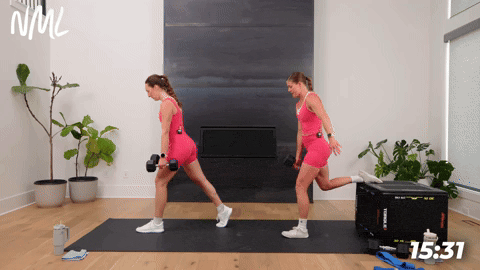
How to Do a Bulgarian Split Squat
- Kneel in front of your bench or chair, then place your left foot behind you on the chair or bench, shoelaces down. Hold a dumbbell in your left hand.
- Step your right foot forward (it will vary for everyone, but a little over a foot in front of your bench). Your front thigh will be parallel to the floor. This is the bottom of your movement.
- Drive through your front right heel, squeezing your right glute to return to standing. Feel your front glute engage to power the movement.
- With control, bend your knee to lower back down to the starting position (back left knee should lower down close to the ground), to make your front thigh parallel with the ground. Shoulders remain stacked over hips throughout the movement.
Modification: Perform a standard reverse lunge or split squat, keeping your back foot on the ground rather than elevating it on a chair.
9. Lateral Lunges
Targets: Glutes, quads, outer thighs and inner thighs.

How to Do a Lateral Lunge
- Start standing with your feet hip-width apart. Hold 1 dumbbell in your right hand.
- Take a large step to the left with your left leg as you sit your hips back, bending your left knee while leaving your right leg straight. Think of performing a single-leg squat with your left leg while your right leg remains straight. Knees and toes are pointing forward.
- Drive off your left foot to reverse the movement, standing back up to the starting position (as you pull your inner thighs together).
10. Step-Ups
Targets: Quads and all 3 parts of the glutes — the gluteus maximus, gluteus medius and gluteus minimus.
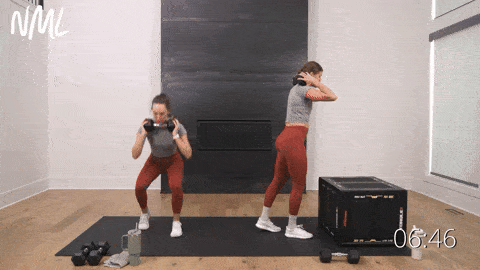
How to Do a Step-Up
- Start standing, feet shoulder-width apart, core tight and engaged. Option to hold a dumbbell vertically at your chest (goblet hold) or racked horizontally on your back.
- Step your right foot up onto a bench or chair, planting your right heel firmly on the surface.
- Using the muscle in your right quad (rather than momentum from your left leg), press through your right heel to stand tall.
- With control, slowly lower your left foot down to touch the ground, returning to the starting position. In this variation, we’re increasing the time under tension by lowering down to the ground on a 3-count.
Modification: The lower the step, the less intense this exercise is. The bottom step of a staircase is a great place to start. If you don’t have a step available, perform a reverse lunge with a knee drive or a staggered squat with a knee drive.
11. Glute Bridges
Targets: Glutes, hamstrings and hip abductor muscles.

How to Do a Glute Bridge
- Lie on your back with your knees bent at 90 degrees and your feet flat on the ground. Hold a dumbbell across your hips, resting the dumbbell on your hip bones.
- Press through your heels to raise your hips off the ground until your knees, hips and shoulders form a straight line. Squeeze your glutes hard and keep your abs drawn in so you don’t overextend your back during the exercise.
- Lower your hips back down to a hovering position and repeat.
12. Standing Calf Raises
Targets: Calf muscles (gastrocnemius and soleus) and Achilles tendon.
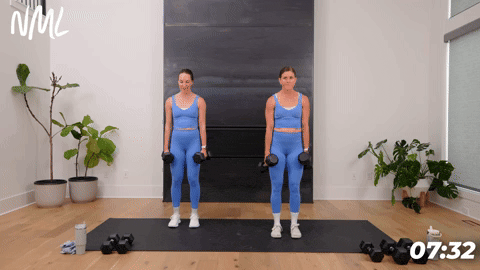
How to Do a Standing Calf Raise
- Start standing on a flat surface, feet shoulder-width apart. Keep your back straight and core engaged to stand tall. Hold a pair of dumbbells in your hands.
- Slowly and with control, lift yourself onto the balls of your feet, heels rising above the ground.
- Lift your heels until you feel a stretch along the back of your legs, balancing on your toes.
- Slowly lower your heels back to the ground, returning to the starting position.
FAQs
The best leg workouts for beginners include simple movements that build strength and stability. Start with squats, lunges and glute bridges. These exercises target all the major lower-body muscles while improving balance and mobility. As a beginner, you can start with bodyweight exercises. Once you feel confident with form and control, you can add resistance bands or dumbbells to increase the challenge.
Ultimately, how often you train your legs will depend on your goals. I recommend 1-2 leg workouts per week, allowing at least 1 rest or active recovery day between sessions. This frequency gives your muscles time to recover and grow stronger while maintaining consistency for progress. If you’re doing full-body workouts, make sure each session includes at least 1 compound leg movement, like squats or deadlifts.
A stationary bike primarily strengthens the quads, hamstrings, glutes and calves, especially when you increase resistance or add sprint intervals. While it’s great for endurance, it’s less effective for building significant muscle mass compared to resistance training. Combining cycling with low-impact strength exercises like squats or lunges will give you the best results.
A 20-minute HIIT session that includes lower-body-focused moves like jump squats and lunges can improve leg strength, endurance and overall cardiovascular fitness. The key is intensity – working hard during each interval with minimal rest. While HIIT boosts power and stamina, pairing it with traditional strength training will lead to better muscle definition.
More Workouts
Lower-BodyPin This: Build Your Leg Day With These 12 Exercises
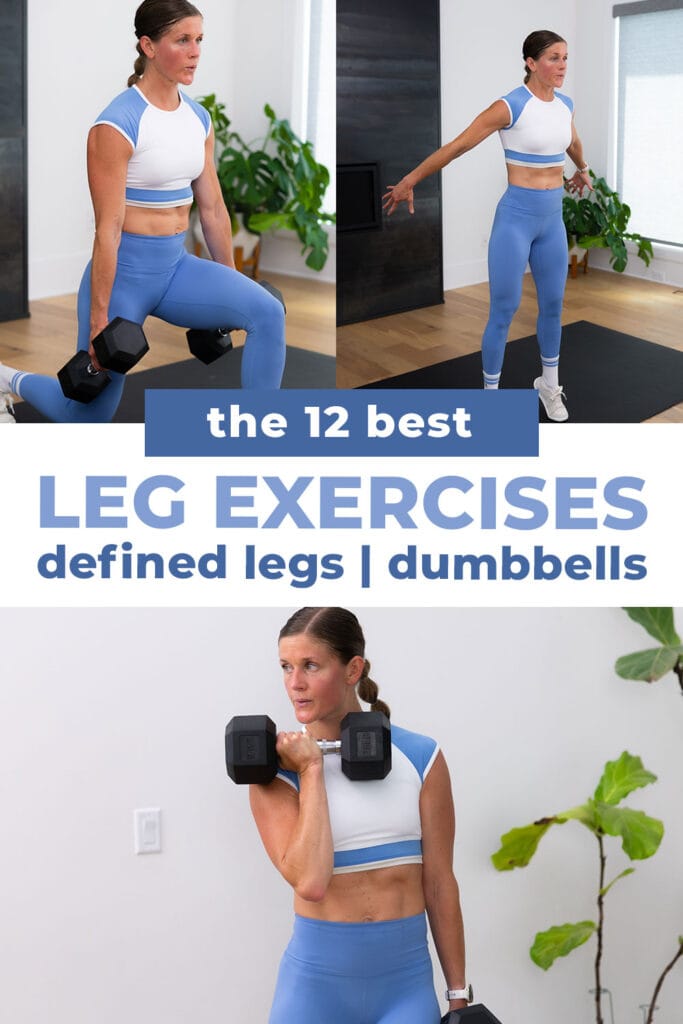










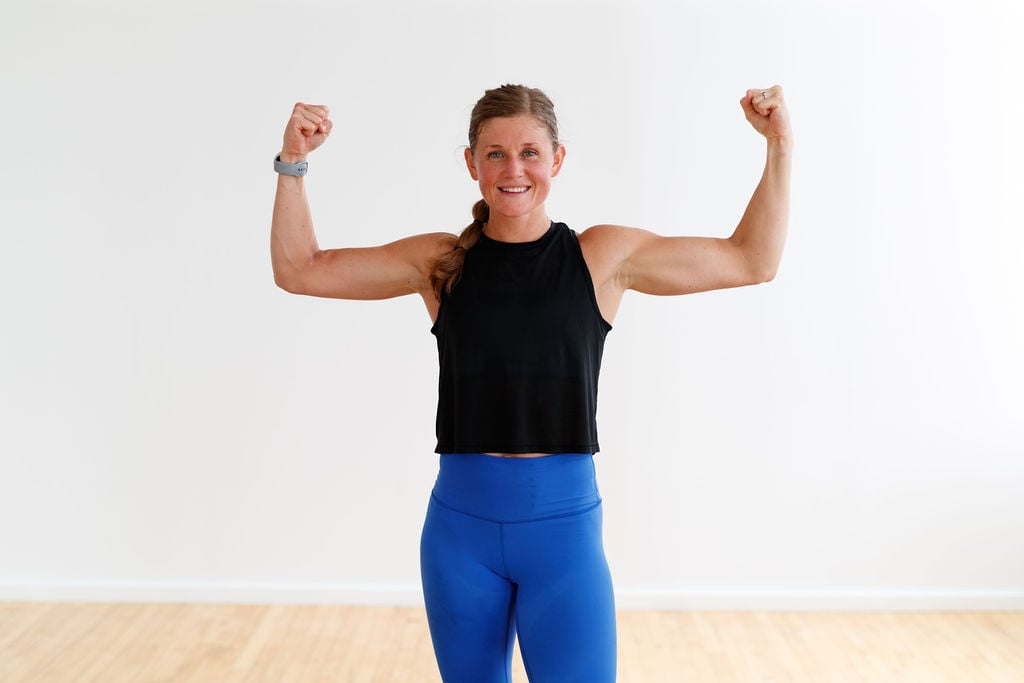
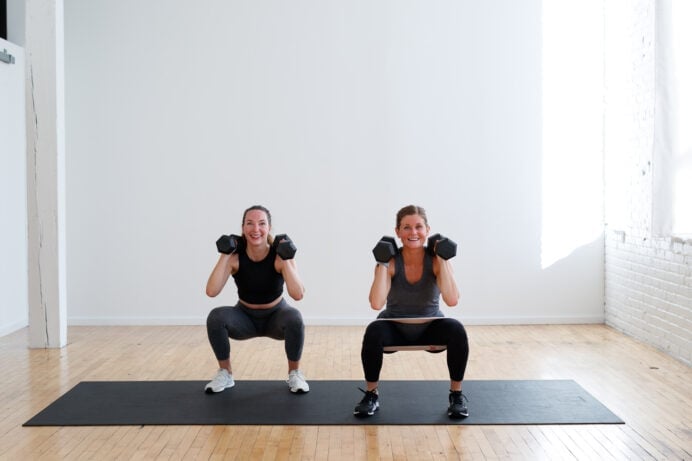
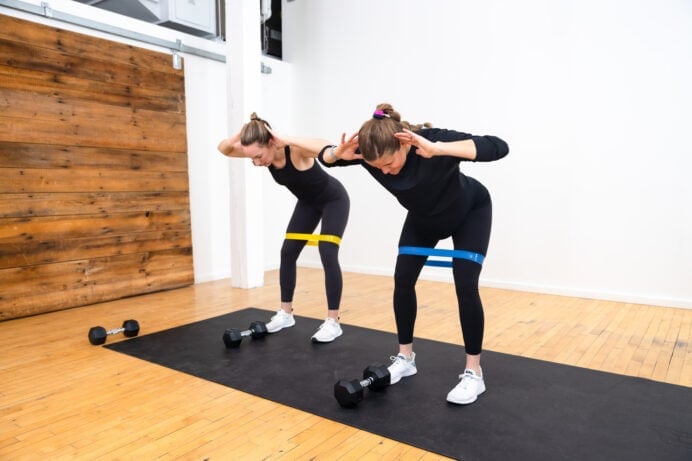
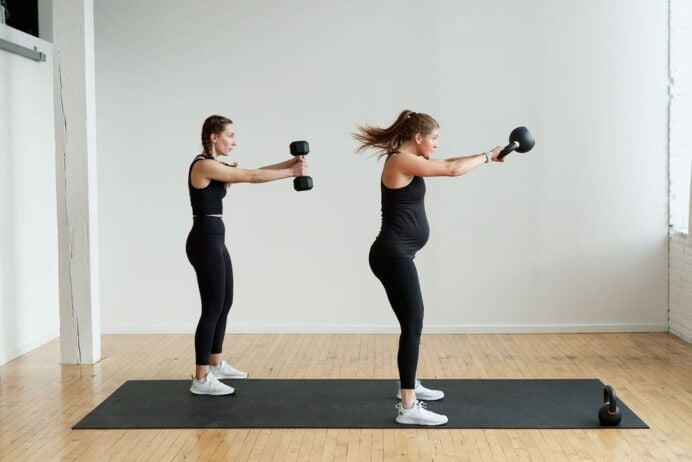
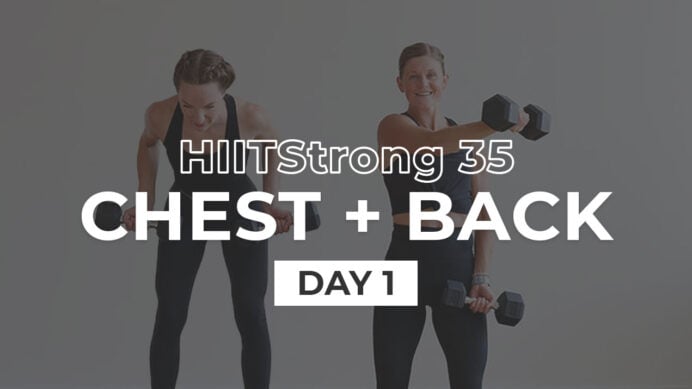
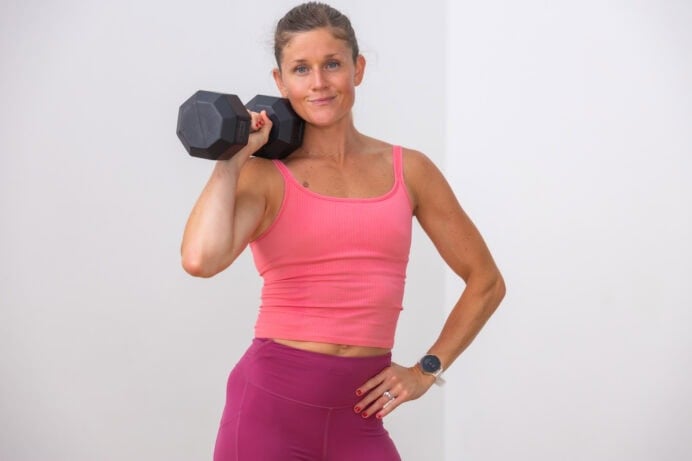

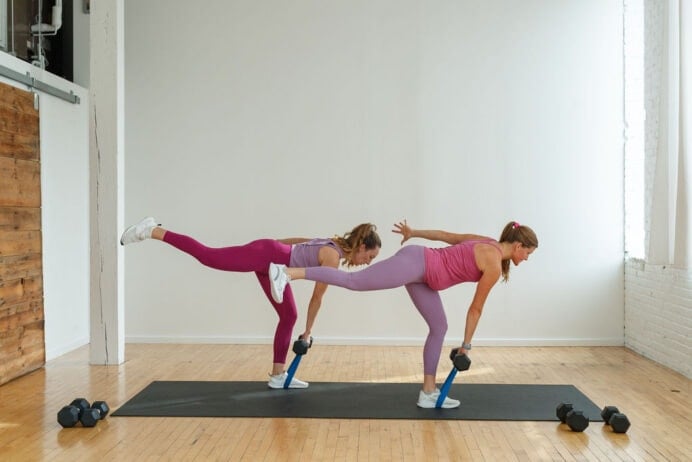
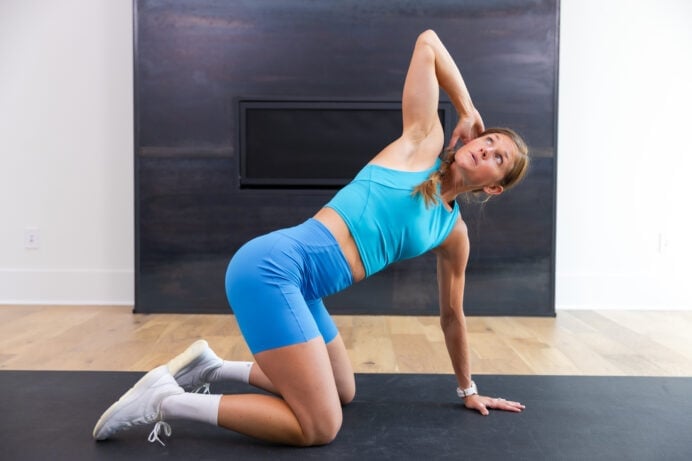
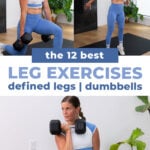
Lindsey,
I’m 60 years old and trying to get back in shape. Can you tell me the name of the box you use for your step ups. Love everything about your website and how you explain and perform the exercises.
Thanks for sharing with us.
Sincerely,
La Vita C.
Hi La Vita! I am so glad to hear you’ve been enjoying the workouts – thank you for following along! I use the Triple Plyo box from Torque Fitness. It’s really great for step-ups and elevated strength exercises. I have more info about all of my home gym equipment here: https://www.nourishmovelove.com/garage-gym-ideas/
– Lindsey
Lindsey, I just did your lower body workout ( loved it). You were using a cloth glute band… didn’t see if on your site for purchase. Would you be willing to share where you got it. The tubing is not great 🙂 Thank you so much! Theresa
Hi Theresa! Thanks for reaching out! We will actually have those available for purchase on our merch site in the next few weeks – stay tuned! -Lindsey